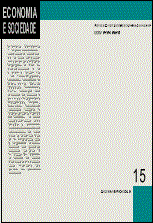Resumo
No artigo analisam-se as conseqüências da estrutura do sistema de crédito internacional sobre o balanço de pagamentos dos países periféricos, na forma de déficit crônico e crescente em transações correntes, em condições de transações externas liberalizadas. Procurou-se demonstrar que a balança comercial tende a ser deficitária e que um superávit contínuo não pode ser gerado pelo ingresso de capitais externos sob qualquer modalidade. Estes são, ao contrário, uma das causas do déficit e o agravam. Como estes resultados decorrem da vigência das leis do mercado, a solução seria restringilas pela regulamentação defensiva das transações externas. Há grande acúmulo de experiência histórica a sustentá-la. Todavia, a regulamentação não é uma solução duradoura, pois o déficit crônico dos países periféricos resulta de uma inferioridade estrutural, expressa em baixos níveis de produtividade. A solução real situa-se, teoricamente, no desenvolvimento estrutural da economia, com base em regulamentação ofensiva, mas a sua viabilidade histórica é duvidosa.
Abstract
The paper assesses the consequences of the structure of the international credit system upon the balance of payments of the periphery countries, in the form of increasing chronic current account deficit, under conditions of liberalized external relations. The attempt has been made to demonstrate that the trade balance tends to be in deficit and that a continuous surplus cannot be generated by the inflow of foreign capital of any sort. They are, on the contrary, one of the causes of the deficit and cause it to increase. Since these features are the outcome of the normal working of market forces, the solution would seem to be to restrain the latter through defensive regulation of foreign transactions, which is in effect supported by ample and recent historical evidence. However, regulation cannot be relied upon as a long run solution, since the chronic deficit of the periphery countries derives from a structural backwardness, as expressed in low levels of productivity. The effective solution would consist, in theory, of a structural upgrading of the economy, supported by offensive regulation, but the historical viability of such a process is doubtfull.
Key words: International monetary system; Globalization; Peripheral economies; Liberalization of trade and finance.
Referências
BORDO, M. D. Gold standard: theory. In: NEWMAN, P., MILGATE, M., EATWELL, J. (Ed.). The New Palgrave dictionary of money & finance. London: Macmillan, 1994. v. 2, p. 267-271.
CORAZZA, G. A interdependência dos bancos centrais em relação ao governo e aos bancos privados. Campinas: Unicamp. IE, 1995. (Tese, Doutoramento).
EICHENGREEN, B. Golden fetters: the gold standard and the great depression 1919- 1939. New York: Oxford University Press, 1995. (1st ed. 1992).
GERMER, C. M. O dinheiro de crédito e as funções do dinheiro no capitalismo. In: ENCONTRO NACIONAL DE ECONOMIA, 25, 1997. Anais… v. 1, p. 336-56, 1997a.
________. Credit money and the functions of money in capitalism. International Journal of Political Economy, v. 27, n. 1, p. 43-72, Spring 1997b.
GRAHAM, E. M. Foreign direct investment. In: NEWMAN, P., MILGATE, M., EATWELL, J. (Ed.). The New Palgrave dictionary of money & finance. London: Macmillan, 1994. v. 2, p. 147-50.
INTERNATIONAL MONETARY FUND. International financial statistics yearbook. Washington, DC: IMF, 1994.
KEYNES, J. M. Indian currency and finance. In: THE COLLECTED writings of John Maynard Keynes. London: Macmillan/Cambridge University Press for the Royal Economic Society, 1971. v. I. (1st ed. 1913).
MARX, K. O capital; crítica da economia política. São Paulo: Abril Cultural, 1983. v. 1, t. 1.
NIVEAU, M. História dos fatos econômicos contemporâneos. São Paulo: Difusão Européia do Livro, 1969. (Original Histoire des faits économiques contemporaines, Presses Universitaires de France, ca. 1966).
SAAD-FILHO, A., LAPAVITSAS, C. A teoria horizontalista da moeda e do crédito: uma análise crítica. Estudos Econômicos, v. 29, n. 1, p. 23-45, 1999.
SHAIKH, A. Free trade, unemployment, and economic policy. In: EATWELL, J. (Ed.). Global unemployment: loss of jobs in the ‘90s. Armonk, N.Y.: M. E. Sharpe, 1996. p. 59-78.
TAVARES, M. C. In: ________, FIORI, J. L. (Org.). Poder e dinheiro: uma economia política da globalização. 4. ed. Petrópolis: Editora Vozes, 1998. p. 27-53.
________, MELIN, L. E. Pós-escrito 1997: a reafirmação da hegemonia norte-americana. In: ________, FIORI, J. L. (Org.). Poder e dinheiro: uma economia política da globalização. 4. ed. Petrópolis: Editora Vozes, 1998. p. 55-86.
WOOD, G. E. Gold exchange standard. In: NEWMAN, P., MILGATE, M., EATWELL, J. (Ed). The New Palgrave dictionary of money & finance. London: Macmillan, 1994. v. 2, p. 256-257.
A Economia e Sociedade utiliza a licença do Creative Commons (CC), preservando assim, a integridade dos artigos em ambiente de acesso aberto.

